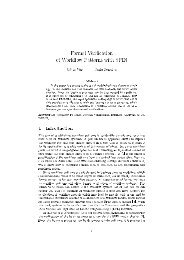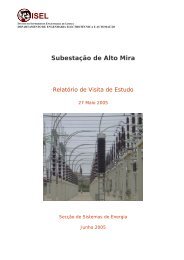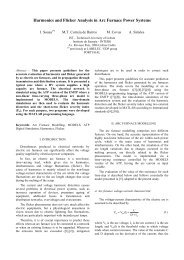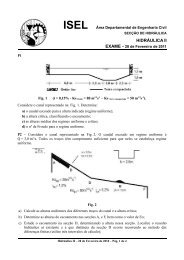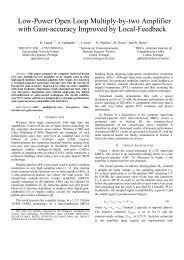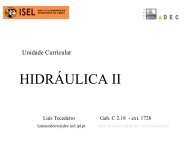Low-Power 6-bit 1-GS/s Two-Channel Pipeline ADC with Open ...
Low-Power 6-bit 1-GS/s Two-Channel Pipeline ADC with Open ...
Low-Power 6-bit 1-GS/s Two-Channel Pipeline ADC with Open ...
You also want an ePaper? Increase the reach of your titles
YUMPU automatically turns print PDFs into web optimized ePapers that Google loves.
<strong>Low</strong>-<strong>Power</strong> 6-<strong>bit</strong> 1-<strong>GS</strong>/s <strong>Two</strong>-<strong>Channel</strong> <strong>Pipeline</strong> <strong>ADC</strong> <strong>with</strong><br />
<strong>Open</strong>-Loop Amplification using Amplifiers <strong>with</strong> Local-Feedback<br />
A. Galhardo<br />
DEEA<br />
Instituto Superior de Engenharia de Lisboa<br />
Lisboa, Portugal<br />
galhardo@deea.isel.ipl.pt<br />
J. Goes, N. Paulino<br />
Universidade Nova de Lisboa/CRI-UNINOVA<br />
Campus da FCT/UNL<br />
2825-114 Monte da Caparica, Portugal<br />
jg@uninova.pt<br />
Abstract—A low-power 1.2 V 6-<strong>bit</strong> 1-<strong>GS</strong>/s time-interleaved<br />
pipeline <strong>ADC</strong> designed in 130 nm CMOS is described. It is<br />
based on a new 2-channel 1.5-<strong>bit</strong> MDAC that performs openloop<br />
residue amplification using a shared amplifier employing<br />
local-feedback. Time mismatches between channels are highly<br />
attenuated, simply by using two passive front-end Sample-and-<br />
Hold circuits, <strong>with</strong> dedicated switch-linearization control<br />
circuits, driven by a single clock phase. Simulated results of the<br />
<strong>ADC</strong> achieve 5.35-<strong>bit</strong> ENOB, <strong>with</strong> 20 mW and <strong>with</strong>out<br />
requiring any gain control/calibration scheme.<br />
I. INTRODUCTION<br />
Wireless short range connectivity <strong>with</strong> high data rate<br />
capabilities, is and will be one of major driven technology<br />
for the consumer electronics mass market. Wireless (USB)<br />
and Ultra Wideband (UWB) Bluetooth are examples of such<br />
technologies since they start from an installed base in the<br />
billions of ports. Software radio UWB receiver<br />
implementation has numerous potential benefits ranging<br />
from low-cost and ease-of-design to flexibility. However<br />
such approach implies analogue-to-digital converters<br />
(<strong>ADC</strong>s) capable of sampling rates in order of <strong>GS</strong>/s, which<br />
constitutes a technical challenge when using a low-cost pure<br />
digital CMOS technology.<br />
Parallel pipeline <strong>ADC</strong>s have been used to achieve<br />
medium resolutions at very high sampling rates [1, 2]. Also<br />
sharing some common blocks between two or more parallel<br />
<strong>ADC</strong>s, in a time-interleaved fashion can reduce the total<br />
power. The closed-loop multiply-by-two residue amplifiers<br />
usually integrated in the pipeline <strong>ADC</strong>s can be replaced by<br />
open-loop amplifiers [3, 4], reducing global size and power.<br />
However, it becomes mandatory to employ either digital<br />
gain-calibration [3] or employ replica circuits for<br />
implementing global-gain control techniques [4].<br />
This work presents a 1.2 V 20 mW 6-<strong>bit</strong> 1<strong>GS</strong>/s 2-channel<br />
pipeline <strong>ADC</strong> designed in a 1.2 V, 130nm 1P-8M CMOS<br />
technology. In each pipelined stage, the open-loop residue<br />
amplification is carried-out by using a shared amplifier<br />
between channels. This amplifier employs local-feedback in<br />
order to achieve constant closed-loop gain against Process-<br />
Supply-Temperature (PVT) variations and thus, avoiding the<br />
need of any digital self-calibration or gain-control<br />
techniques. Time skews between the 2 channels are highly<br />
reduced, by using two passive front-end Sample-and-Hold<br />
(S/H) circuits, <strong>with</strong> dedicated switch-linearization control<br />
(SLC) circuits [5], driven by a single clock phase [6].<br />
Simulations reach a peak SNDR of 34 dB, a SFDR of 47 dB,<br />
a THD of -43 dB and 5.35-<strong>bit</strong> ENOB, for a power dissipation<br />
of 20 mW which corresponds to an energy efficiency better<br />
than 0.5 pJ per conversion. Moreover, all pipelined stages are<br />
made equal and no scaling is used which highly simplifies<br />
the layout effort.<br />
In Section II the architecture of the <strong>ADC</strong>, the timing and<br />
the required circuits for clock-phase generation are<br />
presented. In Section III the basic building-blocks of the<br />
<strong>ADC</strong> are described namely, the S/H, the open-loop 1.5-<strong>bit</strong><br />
multiplying-DAC (1.5-<strong>bit</strong> MDAC) residue amplifiers and the<br />
comparator used in the 1.5-<strong>bit</strong> flash quantizers (1.5-<strong>bit</strong> FQ).<br />
Simulated FFT results and the dynamic performance of the<br />
<strong>ADC</strong> are provided in Section IV, and the main achieved<br />
results are finally summarized in Section V where the<br />
conclusions are drawn.<br />
II. ARCHITECTURE DESCRIPTION AND TIMING<br />
Using two interleaved pipelined <strong>ADC</strong>s in parallel, the<br />
sampling rate is doubled. In Fig. 1, a block diagram the<br />
architecture of the overall 2-channel <strong>ADC</strong> is shown.<br />
v in<br />
S/H 1<br />
φ 1 φ aux<br />
SLC<br />
S/H 2<br />
φ 1n φ aux<br />
SLC<br />
Digital Syncronization and Correction Logic<br />
2 <strong>bit</strong> 2 <strong>bit</strong><br />
2 <strong>bit</strong> 2 <strong>bit</strong><br />
2 <strong>bit</strong> D<br />
FQ11<br />
i<br />
g<br />
i<br />
MDAC11<br />
MDAC21<br />
MDAC31<br />
MDAC41<br />
t<br />
1.5-b<br />
1.5-b<br />
1.5-b<br />
1.5-b<br />
a<br />
l<br />
M<br />
A1 FQ2 A2 FQ3 A3 FQ4 A4 FQ5<br />
u<br />
l<br />
t<br />
i<br />
MDAC12<br />
MDAC22<br />
MDAC32<br />
MDAC42<br />
p<br />
1.5-b<br />
1.5-b<br />
1.5-b<br />
1.5-b<br />
l<br />
e<br />
x<br />
FQ12<br />
e<br />
2 <strong>bit</strong> 2 <strong>bit</strong><br />
2 <strong>bit</strong> 2 <strong>bit</strong><br />
2 <strong>bit</strong> r<br />
Digital Syncronization and Correction Logic<br />
Figure 1. Block diagram of the architecture of the 6-<strong>bit</strong> 2-channel timeinteleaved<br />
<strong>Pipeline</strong> <strong>ADC</strong>.<br />
6 <strong>bit</strong><br />
6 <strong>bit</strong><br />
6 <strong>bit</strong><br />
out
Basically, the fully-differential structure of each pipeline<br />
<strong>ADC</strong> comprises a passive front-end sample-and-hold (S/H),<br />
followed by a cascade of four 1.5-<strong>bit</strong> stages and by a 2-<strong>bit</strong><br />
flash quantizer at the end of the signal path. Each 1.5-<strong>bit</strong><br />
stage comprises a 1.5-<strong>bit</strong> MDAC and a 1.5-<strong>bit</strong> quantizer. The<br />
10 output <strong>bit</strong>s provided by the 5 quantizers are then digitally<br />
synchronized and a net resolution (N) of 6 <strong>bit</strong>s is available at<br />
the output after applying synchronization and standard<br />
digital correction (summing all five 2-<strong>bit</strong> words <strong>with</strong> 1-<strong>bit</strong><br />
overlap). Each 1.5-<strong>bit</strong> MDAC block operates at 500 MS/s in<br />
order to relax the speed requirements of the amplifiers by a<br />
factor of 2. Since MDACs of the same stage, but of different<br />
channel, operate in opposite phases, they are able to share the<br />
same amplifier. Four equal sized amplifiers are, therefore,<br />
shared between channels, namely A1 to A4.<br />
The 1.5-b quantizers FQ11 and FQ12, adjacent to the<br />
lower pipeline perform quantizations at 500 MHz. The other<br />
four 1.5-b quantizers namely, FQ2, FQ3, FQ4 and FQ5,<br />
operate at 1 GHz, since they are also shared between stages<br />
in order to reduce area. Finally, at the output, a digital<br />
multiplexer operating at full speed is used in order to provide<br />
the 6-<strong>bit</strong> digital output at a 1 <strong>GS</strong>/s clock rate.<br />
S/H1<br />
φ 1n<br />
S/H2<br />
φ 1<br />
MDAC<br />
11<br />
MDAC<br />
12<br />
FQ11<br />
φ F1n<br />
S(1)<br />
S(1)<br />
H(1)<br />
S(2)<br />
S(1)<br />
H(1)<br />
S(3)<br />
H(2)<br />
RA(1)<br />
S(2)<br />
S(3)<br />
H(3)<br />
S(4)<br />
S(3)<br />
RA(2)<br />
H(3)<br />
S(5)<br />
H(4)<br />
RA(3)<br />
S(4)<br />
S(5)<br />
H(5)<br />
S(6)<br />
S(5)<br />
RA(4)<br />
H(5)<br />
S(7)<br />
H(6)<br />
RA(5)<br />
S(6)<br />
S(7)<br />
H(7)<br />
S(8)<br />
S(7)<br />
RA(6)<br />
H(7)<br />
S(9)<br />
H(8)<br />
RA(7)<br />
S(8)<br />
S(9)<br />
H(9)<br />
S(10)<br />
S(9)<br />
RA(8)<br />
H(9)<br />
S(11)<br />
H(10)<br />
RA(9)<br />
S(10)<br />
S(11)<br />
H(11)<br />
S(12)<br />
S(11)<br />
RA(10)<br />
All clock-phase signals are obtained from a 1 GHz<br />
master clock, clk, as depicted in Fig. 3. No non-overlapping<br />
clock-phase generators are used. The first D Flip-Flop (D-<br />
FF) is used to lower the frequency and obtain the 500 MHz,<br />
φ 1 and φ 1n, complementary phases. Using φ 1 and φ 1n, and<br />
the master clock the 90º phase-shift phases, φ F and φ Fn, to<br />
drive quantizers FQ2 to FQ5 are generated. Thought a<br />
second D-FF, phases φ F1 and φ F1n are produced to drive<br />
quantizers FQ12 and FQ11, respectively. Finally, auxiliary<br />
phase φ aux is generated as shown in Fig. 3 using a simple OR<br />
gate. All phases are properly buffered using digital buffers<br />
<strong>with</strong> the driving capability sized according to the load.<br />
clk<br />
φ 1<br />
φ F<br />
III.<br />
D Q<br />
D-FF _<br />
clk Q<br />
D Q<br />
D-FF _<br />
clk Q<br />
φ F1<br />
φ F1n<br />
φ 1<br />
φ 1n<br />
φ F<br />
clk<br />
Figure 3. Clock signals generation.<br />
φ Fn<br />
φ F<br />
φ aux<br />
DESIGN OF THE BASIC BUILDING-BLOCKS<br />
A. The 1.5-<strong>bit</strong> MDAC<br />
Instead of using a closed-loop amplifier <strong>with</strong> high gain,<br />
as usually employed in the conventional schemes, it is used<br />
an open-loop amplifier in the MDAC stages [3, 4].<br />
V REFN<br />
/2<br />
V REFP<br />
/2<br />
V CM<br />
X<br />
Y<br />
Z<br />
FQ12<br />
φ F1<br />
MDAC<br />
21<br />
MDAC<br />
22<br />
FQ2<br />
φ Fn<br />
S(2) H(2) S(4) H(4) S(6) H(6) S(8) H(8) S(10) H(10)<br />
S(1) Q(1) S(3) Q(3) S(5) Q(5) S(7) Q(7) S(9) Q(9)<br />
S(2) Q(2) S(4) Q(4) S(6) Q(6) S(8) Q(8) S(10)<br />
φ 1<br />
φ 1n<br />
V REFN<br />
1<br />
v ip<br />
φ<br />
C Sp 1n φ1 in p<br />
+ +<br />
AMP<br />
φ<br />
v op<br />
vin<br />
φ 1n<br />
in n<br />
G=2<br />
_ _<br />
v on<br />
φ 1<br />
φ<br />
C 1n<br />
Sn<br />
V REFP<br />
/2 X V REFN<br />
V REFN<br />
/2 Y<br />
Z<br />
V CM<br />
φ aux<br />
Figure 2. Control clock signals and architecture timing.<br />
The control and timing signals are shown in Fig. 2. The<br />
single-phase technique described in [6] is used and, hence,<br />
only one clock phase is used, φ 1 , and it complementary<br />
version, φ 1n . These complementary phases are used to drive<br />
the two S/H blocks and all 1.5-<strong>bit</strong> MDACs. Front-end<br />
quantizers FQ11 and FQ12 (operating at 500 MHz) are<br />
controlled by clock signals φ F1 and φ F1n and, the remaining<br />
quantizers (operating at 1 GHz) are driven by phases φ F and<br />
φ Fn . In order to let the amplifiers to settle in a complete 2 ns<br />
time-slot, the quantization of all 1.5-<strong>bit</strong> flash <strong>ADC</strong>s is done<br />
in the middle of the sampling-phase of the 1.5-<strong>bit</strong> MDACs of<br />
the same stage. Finally, an auxiliary clock signal φ aux, used<br />
to cancel the time-skew errors between the two channels, is<br />
also displayed.<br />
Figure 4. Fully-differential implementation of the 1.5-<strong>bit</strong> MDAC based<br />
on open-loop amplification.<br />
As illustrated in Fig. 4, the input voltage, v ip , is sampled<br />
into C Sp (nominally set to 0.3 pF due to KT/C noise<br />
constraints) during phase φ 1n. During φ 1, the sampled signal<br />
is amplified by a gain of 2, and the output amplified residue<br />
is produced according to<br />
⎛ VREFD<br />
VREFD<br />
⎞<br />
v = v − v = −2⎜v<br />
+ X − Y + Z ⋅ 0⎟<br />
(1)<br />
od op on<br />
id<br />
⎝ 2 2 ⎠<br />
where vid<br />
= vip<br />
− vin<br />
, VREFD<br />
= VREFP<br />
−VREFN<br />
, and the<br />
digital signals X, Y and Z are provided by the local 1.5-<strong>bit</strong><br />
quantizer and only one is active at a time. The residue<br />
amplification gain, G, needs to be made accurately equal to 2<br />
(<strong>with</strong> an error smaller than ±1.56 % for 6-<strong>bit</strong> accuracy). The
eference levels V REFP /2 and V REFN /2 used are, respectively,<br />
0.675 V and 0.425 V, corresponding toV REFP = 0.8V<br />
,<br />
VREFN<br />
= 0.3V and to an output common mode level, V CM , of<br />
0.55 V (set to this value to allow operation down to 1.08 V).<br />
V DD<br />
V DD<br />
V BP<br />
V DD<br />
M 1<br />
M 4<br />
R<br />
v M 2<br />
on<br />
V CMFB 2<br />
in n<br />
in p<br />
M 5<br />
V BN<br />
M 3<br />
V CMFB<br />
CMFB<br />
v on<br />
v op<br />
V CM<br />
R 1<br />
V REFP<br />
V DD<br />
Figure 5. Fully-differential closed-loop amplifier.<br />
The proposed amplifier structure based on local feedback<br />
is shown in Fig. 5. It is based on a two-stage amplifier (M 2<br />
and M 5 devices) <strong>with</strong> no inverting feedback [7]. Transistor<br />
M 2 acts as a source follower, copying the input signal in p to<br />
the resistor node. In the second stage, the transistor M 5<br />
delivers the output voltage, v op , and current. The input<br />
transistor is PMOS type <strong>with</strong> bulk shorted to its source to<br />
reduce body effect, and devices M 1 , M 3 and M 4 operate as<br />
current sources. The bias circuit, not shown, provides the<br />
required bias voltages V BP and V BN . The gain is<br />
approximately equal to 1+R 2 /R 1 , but the capacitive<br />
attenuation due to parasitics at the input (gate of M 2 ) reduces<br />
it. The sampling capacitor, C Sp , together <strong>with</strong> the input<br />
parasitic capacitance defines a trade-off between linearity,<br />
speed and power dissipation. The overall voltage gain can be<br />
adjusted varying the value of R 1 . The values of 315 Ω and<br />
500 Ω, respectively for R 1 and R 2 , are chosen. Input and<br />
output stages are biased <strong>with</strong> 100 µA and 500 µA,<br />
respectively. To avoid accumulation in the common-mode<br />
errors by cascading several pipeline stages, a common-mode<br />
feedback circuit (CMFB), is employed. It senses the two<br />
output voltages, compares their level <strong>with</strong> V CM and adjusts<br />
the output common-mode voltage thought node V CMFB .<br />
Switches connected to the MDAC input signals are<br />
implemented <strong>with</strong> a CMOS asymmetrical transmission-gates<br />
(ATG) employing simple bulk-switching in the PMOS<br />
device. Dummy switches (half-sized) are used to minimize<br />
signal dependent charge injection. The remaining switches<br />
are implemented using single NMOS or PMOS transistors.<br />
B. The Passive front-end Sample-and- hold circuits<br />
The two front-end fully-differential S/H circuits are<br />
based on a passive structure comprising two 4 pF sampling<br />
capacitors and two ATGs (per each S/H). Each ATG switch<br />
is driven by a dedicated switch linearization control (SLC)<br />
circuit, described in detail in [5]. The complete schematic of<br />
the SLC circuit, is shown in Fig. 6(a). The main transistors<br />
M 1 and M 2 form the CMOS switch, and are respectively<br />
v op<br />
sized <strong>with</strong> aspect ratios of 20/0.12 and 80/0.12. Their<br />
controlled gate voltages are function of the input voltage, v in ,<br />
resulting in very highly linear switch <strong>with</strong>out having any<br />
reliability problems [5]. Note that the fact of connecting the<br />
MDAC sampling capacitors, C S , charged <strong>with</strong> the input<br />
signal of the previous sample to the passive S/H, C SH , only<br />
causes a low-pass filtering function of the type<br />
−<br />
( )<br />
1/ 2<br />
−1<br />
H z = z ( CSH<br />
/( CSH<br />
+ CS<br />
)) /(1 − z ( CS<br />
/( CSH<br />
+ CS<br />
))) .<br />
Since C SH is made, at least, one order of magnitude larger<br />
than C S , the attenuation at Nyquist frequency is below 1dB.<br />
At DC there is no attenuation. As long as the critical parasitic<br />
capacitances at the inputs of the amplifier of the MDAC are<br />
kept small, the distortion will be negligible at 6-<strong>bit</strong> level.<br />
V DD<br />
v in<br />
φ 1 φ<br />
v 1s<br />
out<br />
φ aux<br />
φ 1sn<br />
V DD<br />
φ 1 M 5<br />
φ 1<br />
φ 1s<br />
φ 1n<br />
φ 1s<br />
M 6<br />
φ 1<br />
φ 1n<br />
φ 1n M 2<br />
φ 1<br />
φ 1n M<br />
φ 1<br />
1<br />
V DD V DD V DD<br />
φ 1n<br />
φ 1n<br />
φ 1<br />
φ 1n<br />
M 4<br />
φ 1sn<br />
M 3<br />
φ 1sn<br />
φ 1ns<br />
φ 1nsn<br />
(a)<br />
(b)<br />
Figure 6. (a) Schematic of the SLC circuit used to linearize CMOS (ATG<br />
type) input switches (M 1 and M 2); (b) Generation of syncronization signals.<br />
It is known the clock signals, in this case φ 1 and φ 1n,<br />
might not have the same width, originating a sampling time<br />
error. This time-skew error [8, 9], produce in the output data<br />
spectrum of two interleaved structures, a frequency function<br />
of the input signal frequency, F in , and function of half the<br />
sampling frequency, F S , i.e. at F in +F S /2. Fig. 7(a) shows the<br />
simulated FFT spectrum of the output of the 6-<strong>bit</strong> <strong>ADC</strong>,<br />
<strong>with</strong>out mismatch error cancellation, when a 415 MHz fullscale<br />
input signal is applied together <strong>with</strong> an intentionally set<br />
time-mismatch of 150 ps. The tone appears as a mirrored<br />
image of the main frequency, <strong>with</strong> centre at F S /4.<br />
AMPLITUDE (dB)<br />
0<br />
F F<br />
-10<br />
in -10<br />
in<br />
-20<br />
-20<br />
-30<br />
-30<br />
time-skew<br />
time-skew<br />
-40<br />
-40<br />
-50<br />
HD3<br />
HD3<br />
-50<br />
-60<br />
-60<br />
-70<br />
-70<br />
-80<br />
-80<br />
-90<br />
-90<br />
-100<br />
-100<br />
0 0.5 1 1.5 2 2.5 3 3.5 4 4.5 5<br />
0 0.5 1 1.5 2 2.5 3 3.5 4 4.5 5<br />
x 10 8<br />
x 10 8<br />
ANALOG INPUT FREQ UENCY (Hz )<br />
ANALOG INPUT FREQUENCY (Hz)<br />
(a)<br />
(b)<br />
Figure 7. FFT spectrum of the output data of the <strong>ADC</strong>: (a) <strong>with</strong>out<br />
mismatch time-skew cancelation; (b) <strong>with</strong> mismatch time-skew<br />
cancelation.<br />
AMPLITUDE (dB)<br />
0
Using the same auxiliary clock signal, φ aux, and two<br />
NAND gates, the original clock signals, φ 1 and φ 1n, can be<br />
converted into synchronized signals, φ 1s and φ 1ns, according<br />
to the circuit shown in Fig. 6 (b). A second synchronized pair<br />
is also obtained (complementary versions, φ 1sn and φ 1nsn) by<br />
this simple circuit. These signals are then used for locally<br />
and accurately control the gate voltages of the main CMOS<br />
sampling CMOS switch (M 1 , M 2 ), acting through the SLC<br />
auxiliary transistors, M 3 , M 4 , M 5 and M 6 , as displayed in Fig.<br />
6 (a). The switches of the first S/H block, instead of<br />
sampling during phase φ 1, are sampling during φ 1s.<br />
Likewise, the CMOS input sampling switch of the second<br />
S/H block, samples during φ 1ns. When this technique is<br />
applied, there is an efficient cancellation of the time-skew<br />
effect, as shown in Fig. 7 (b) where the same time mismatch<br />
of 150 ps and the same input signal frequency are used.<br />
C. The Flash Quantizer<br />
Each 1.5-<strong>bit</strong> quantizer consists of 2 comparators followed<br />
by a thermometer-to-binary digital encoder and by an X, Y, Z<br />
encoder. Each comparator comprises an input switchedcapacitor<br />
divider network to define the threshold level,<br />
followed by an ordinary dynamic preamplifier/positivefeedback<br />
latch. This comparator was optimized using<br />
exhaustive Monte-Carlo simulations in order to achieve lowoffset,<br />
reduced kickback noise, high mean-time to failure,<br />
and low-power dissipation at the desired speed of operation.<br />
IV. SIMULATION RESULTS<br />
The 1.2 V, 6-<strong>bit</strong>, 1 <strong>GS</strong>/s 2-channel pipeline <strong>ADC</strong> was<br />
fully designed and simulated at transistor level in a 130nm<br />
1P-8M CMOS technology. In order to simplify the layout<br />
effort, all pipelined stages are equally sized, i.e. no scaling is<br />
applied to the 1.5-<strong>bit</strong> MDACs. A scaling-down approach<br />
would optimize further the overall power. Fig. 8 displays the<br />
FFT (1024 bins) of the <strong>ADC</strong> output clocked at 1 GHz when<br />
a full-scale input of 315 MHz is applied.<br />
AMPLITUDE (dB)<br />
0<br />
-10<br />
-20<br />
-30<br />
-40<br />
-50<br />
-60<br />
-70<br />
-80<br />
-90<br />
HD3<br />
-100<br />
0 0.5 1 1.5 2 2.5 3 3.5 4 4.5 5<br />
ANALOG INPUT FREQUENCY (Hz)<br />
x 10 8<br />
Figure 8. Simulated FFT Spectrum <strong>with</strong> 1024 <strong>bit</strong>s for f clk=1 GHz and<br />
f in=315 MHz (coherent sampling).<br />
A peak SNR of 34.6 dB is obtained through analytical<br />
calculations when 4 pF and 0.3 pF unit capacitors are used<br />
respectively in the S/Hs and 1.5-<strong>bit</strong> MDACs. Simulations<br />
HD5<br />
HD11<br />
show a THD of –43 dB, a SFDR of 47 dB, and a peak SNDR<br />
larger than 34 dB corresponding to an ENOB better than<br />
5.35 <strong>bit</strong>s. The Gain error/time-skew spur is 50 dB below the<br />
signal. Due to the single-phase scheme used, the highest<br />
harmonics are HD5 and HD11 rather than HD3.<br />
The circuit dissipates less than 20 mW (11 mW analog<br />
and 9 mW digital) <strong>with</strong> 1.2 V and at 1 <strong>GS</strong>/s, corresponding<br />
to an energy efficiency better than 0.5 pJ. When comparing<br />
the energy efficiency <strong>with</strong> the state-of-the-art of lowresolution<br />
pipeline <strong>ADC</strong>s employing open-loop residue<br />
amplification [4] (ENOB=5.3 <strong>bit</strong>s, Fs=800 MS/s, <strong>Power</strong>=105<br />
mW), this work exhi<strong>bit</strong>s an improvement (based on<br />
simulation results) of a factor higher than 6.6. Furthermore,<br />
no calibration scheme is required.<br />
V. CONCLUSIONS<br />
A low-power 1.2 V 6-<strong>bit</strong> 1-<strong>GS</strong>/s time-interleaved<br />
pipeline <strong>ADC</strong> designed in 130 nm CMOS was described. It<br />
is based on a new 2-channel 1.5-<strong>bit</strong> MDAC that performs<br />
open-loop residue amplification using a shared amplifier<br />
employing local-feedback. Time mismatches between<br />
channels are highly attenuated, simply by using two passive<br />
front-end S/H circuits, <strong>with</strong> dedicated SLC circuits, driven<br />
by a single clock phase. Simulated results of the <strong>ADC</strong><br />
achieve 5.35-<strong>bit</strong> ENOB, <strong>with</strong> less than 20 mW and <strong>with</strong>out<br />
requiring any gain control/calibration scheme.<br />
ACKNOWLEDGEMENTS<br />
This work was partially supported by the Portuguese Foundation for<br />
Science and Technology (FCT/MCTES) under LEADER (PTDC/EEA-<br />
ELC/69791/2006), SIPHASE (POSC/EEA-ESSE/61863/2004) and SPEED<br />
(PTDC/EEA-ELC/66857/2006) projects.<br />
REFERENCES<br />
[1] C. S. G. Conroy, D. W. Cline, and P. R. Gray, “An 8-b 85-MS/s parallel<br />
pipeline A/D converter in 1-µm CMOS,” IEEE J. Solid-State Circuits, vol.<br />
28, pp. 447–454, Apr. 1993.<br />
[2] S. Gupta, et. al., “A 1<strong>GS</strong>/s 11b Time-Interleaved <strong>ADC</strong> in 0.13um<br />
CMOS”, Proc. IEEE ISSCC Dig. Tech. Papers, pp. 576–577, Feb. 2006.<br />
[3] B. Murmann and B. E. Boser, “A 12-<strong>bit</strong> 75 Ms/s pipelined <strong>ADC</strong> using<br />
open-loop residue amplifier,” IEEE J. Solid-State Circuits, vol. 38, no. 12,<br />
pp. 2040–2050, Dec. 2003.<br />
[4] Ding-L. Shen, Tai-C. Lee, “A 6-<strong>bit</strong> 800-MS/s <strong>Pipeline</strong>d A/D Converter<br />
With <strong>Open</strong>_Loop Amplifiers”, IEEE J. Solid-State Circuits, vol. 42, no. 2,<br />
pp. 258-268, Feb. 2007.<br />
[5] A. Galhardo, et al., “Novel Linearization Technique for <strong>Low</strong>-Distortion<br />
High-Swing CMOS Switches <strong>with</strong> Improved Reliability”, Proc. IEEE<br />
ISCAS’06, pp. 2001-2004, May 2006.<br />
[6] A. Galhardo, et al., “Design of <strong>Low</strong>-Voltage <strong>Low</strong>-<strong>Power</strong> <strong>Pipeline</strong><br />
<strong>ADC</strong>s Using a Single-Phase Scheme”, IEE Proc. ADDA’2005, pp. 195-<br />
200, July 2005.<br />
[7] K. Philips, E. Dijkmans, “A Variable Gain IF Amplifier <strong>with</strong> -67dBc<br />
IM 3-Distortion at 1.4V pp Output in 0.25 µm CMOS”, Symposium on VLSI<br />
Circuits Digest of Technical Papers, pp. 81-82, June 2001.<br />
[8] M. Waltari, K. Halonen, “Timing Skew Insensitive Switching for<br />
Double-Sampled Circuits”, Proc. IEEE ISCAS’99, vol.2, pp. 61-64, June<br />
1999.<br />
[9] G. Léger, et al., “Impact of Random <strong>Channel</strong> Mismatch on the SNR and<br />
SFDR of Time-Interleaved <strong>ADC</strong>s”, IEEE Trans, Circuits ans Systems – I,<br />
vol. 51, no. 1, pp. 140-150, Jan. 2004.





